Julia Margaret Cameron
| Julia Margaret Cameron | |
|---|---|
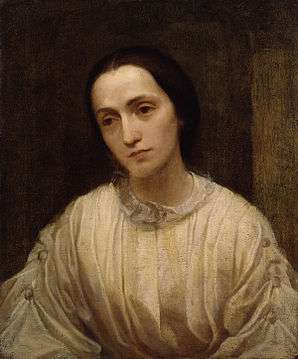 Painting of Julia Margaret Cameron by George Frederic Watts, c. 1850–1852 | |
| Born |
Julia Margaret Pattle 11 June 1815 Calcutta, British India |
| Died |
26 January 1879 (aged 63) Kalutara, British Ceylon |
| Nationality | British |
| Known for | Photography |

Julia Margaret Cameron (née Pattle; 11 June 1815 Calcutta – 26 January 1879 Kalutara, Ceylon) was a British photographer.[1] She became known for her portraits of celebrities of the time, and for photographs with Arthurian and other legendary or heroic themes.
Cameron's photographic career was short, spanning eleven years of her life (1864–1875). She took up photography at the relatively late age of 48, when she was given a camera as a present.[2] Her style was not widely appreciated in her own day: her choice to use a soft focus and to treat photography as an art as well as a science, by manipulating the wet collodion process, caused her works to be viewed as "slovenly", marred by "mistakes" and bad photography. She found more acceptance among pre-Raphaelite artists than among photographers.[3] Her work has influenced modern photographers, especially her closely cropped portraits.[4] Her house, Dimbola Lodge, on the Isle of Wight is open to the public.
Early life
Julia Margaret Cameron was born Julia Margaret Pattle in Calcutta, India, to Adeline Marie de l'Etang and James Peter Pattle, a British official of the East India Company. Adeline de l'Etang was the daughter of Chevalier Ambrose Pierre Antoine de l'Etang, who had been a page of Marie Antoinette as well as an officer in the Garde du Corps of King Louis XVI. He had married the Indian-born Therese Blin de Grincourt, a daughter of French aristocrats.[5]
Marriage
Cameron was educated in France, but returned to India, and in 1838 married Charles Hay Cameron, a jurist and member of the Law Commission stationed in Calcutta, who was twenty years her senior. They had five children together, and also raised five young relations and an Irish girl called Mary Ryan whom Cameron adopted and used as a frequent photographic model.[6]
In 1848, Charles Hay Cameron retired, and the family moved to London, England. Cameron's sister, Sarah Prinsep, had been living in London and hosted a salon at Little Holland House, the dower house of Holland House in Kensington, where famous artists and writers regularly visited. In 1860, Cameron visited the estate of poet Alfred Lord Tennyson on the Isle of Wight. Cameron was taken with the location, and the Cameron family purchased a property on the island soon after. They called it Dimbola Lodge after the family's Ceylon estate.
Photography
.jpg)
In 1863, when Cameron was 48 years old, her daughter gave her a camera as a present, thereby starting her career as a photographer. Within a year, Cameron became a member of the Photographic Societies of London (1864) and Scotland. She remained a member of the Photographic Society, London, until her death.[7] In her photography, Cameron strove to capture beauty. She wrote, "I longed to arrest all the beauty that came before me and at length the longing has been satisfied."[8][9] In 1869 she collated and gave what is now known as The Norman Album to her daughter and son-in-law in gratitude for having introduced her to photography.[10] The album was later deemed by the Reviewing Committee on the Export of Works of Art to be of "outstanding aesthetic importance and significance to the study of the history of photography and, in particular, the work of Julia Margaret Cameron – one of the most significant photographers of the 19th century."[11]
The basic techniques of soft-focus "fancy portraits", which she later developed, were taught to her by David Wilkie Wynfield. She later wrote that "to my feeling about his beautiful photography I owed all my attempts and indeed consequently all my success".[12]
Lord Tennyson, her neighbour on the Isle of Wight, often brought friends to see the photographer and her works. At the time, photography was a labour-intensive art that also was highly dependent upon crucial timing. Sometimes Cameron was obsessive about her new occupation, with subjects sitting for countless exposures as she laboriously coated, exposed, and processed each wet plate. The results were unconventional in their intimacy and their use of created blur both through long exposures and leaving the lens intentionally out of focus. This led some of her contemporaries to complain and even ridicule the work, but her friends and family were supportive, and she was one of the most prolific and advanced amateurs of her time. Her enthusiasm for her craft meant that her children and others sometimes tired of her endless photographing, but it also left us with some of the best of records of her children and of the many notable figures of the time who visited her.
During her career, Cameron registered each of her photographs with the copyright office and kept detailed records. Her shrewd business sense is one reason that so many of her works survive today. Another reason that many of Cameron's portraits are significant is because they are often the only existing photograph of historical figures, becoming an invaluable resource. Many paintings and drawings exist, but, at the time, photography was still a new and challenging medium for someone outside a typical portrait studio.
The bulk of Cameron's photographs fit into two categories—closely framed portraits and illustrative allegories based on religious and literary works. In the allegorical works in particular, her artistic influence was clearly Pre-Raphaelite, with far-away looks, limp poses, and soft lighting.[13]
Portraits
.jpg) Sir John Herschel 1867
Sir John Herschel 1867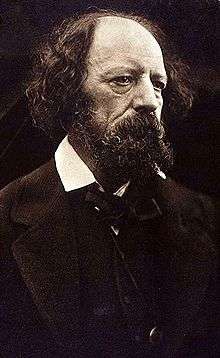

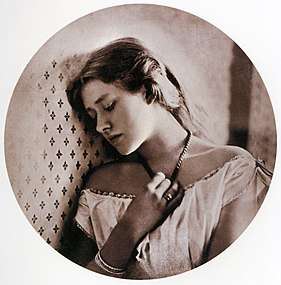 Ellen Terry 1864
Ellen Terry 1864
Cameron's sister ran an artistic salon at Little Holland House, which gave Cameron many famous subjects for her portraits. Some of her famous subjects are: Charles Darwin, Alfred Lord Tennyson, Robert Browning, John Everett Millais, William Michael Rossetti, Edward Burne-Jones, Ellen Terry, and George Frederic Watts. Most of these distinctive portraits are cropped closely around the subject's face and are in soft focus. Often Cameron was a friend of these Victorian celebrities, and, knowing them well, tried to capture their personalities in her photographs. Among Cameron's lesser-known models was Mary Emily ('May') Prinsep, wife of Hallam Tennyson, 2nd Baron Tennyson, the elder son of Alfred Tennyson and a British colonial administrator. Cameron's portraits of May Prinsep, taken on the Isle of Wight, include both more conventional studio-like portraits and allegorical subjects drawn from Romantic poetry.[14]
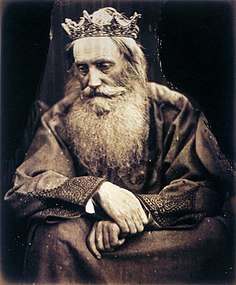 Sir Henry Taylor as King David 1866
Sir Henry Taylor as King David 1866 Parting of Sir Lancelot and Queen Guinevere 1874
Parting of Sir Lancelot and Queen Guinevere 1874
Photographic illustrations
Cameron's posed photographic illustrations represent the other half of her work. In these illustrations, she frequently photographed historical scenes or characters drawn from literary works, which often took the quality of oil paintings. Cameron's friendship with Tennyson led to him asking her to photograph illustrations for his Idylls of the King. These photographs are designed to resemble oil paintings from the same time period, including rich details such as historical costumes and intricate draperies. Today, these posed works are sometimes dismissed by art critics. Nevertheless, Cameron saw these photographs as art, comparable to the Old Masters paintings they imitated.
Later life
In 1875, the Camerons moved to Ceylon, (now Sri Lanka). Cameron continued to practise photography, but she produced many fewer images. Those she did were of posed Ceylonese people, paralleling the posed pictures that Cameron had taken of neighbours in England. Cameron died while in Ceylon. Her death is attributed to having caught a bad chill and she died in Kalutara, Ceylon in 1879.
Legacy
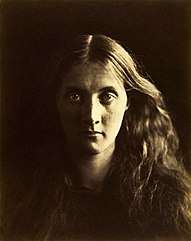
Cameron's niece Julia Prinsep Stephen (née Jackson; 1846–1895) wrote the biography of Cameron that appeared in the first edition of the Dictionary of National Biography, 1886.[15] Julia Stephen was the mother of Virginia Woolf, who wrote a comic portrayal of the "Freshwater circle" in her only play Freshwater. Woolf, in collaboration with Roger Fry, edited a collection of Cameron's photographs that was published in 1926.[16]
It was not until 1948, however, that Cameron's photography became more widely known, when Helmut Gernsheim wrote a book on her work.[17] However he later noted that although a great photographer, Cameron had "left no mark" on the aesthetic history of photography because her work was not appreciated by her fellow photographers and thus not imitated.[18] Her standing has since changed, but even by 1975 when Imogen Cunningham commented "I'd like to see portrait photography go right back to Julia Margaret Cameron. I don't think there's anyone better", she went on to say her own work had not been influenced by Cameron as she had not been aware of it when she was starting out.[18]
In 2003, the J. Paul Getty Museum published a complete catalogue of Cameron's known and surviving photographs. One caption of a portrait of Alice Liddell (whom Cameron photographed as Alethea, Pomona, Ceres, and St. Agnes in 1872) claims that "Cameron's photographic portraits are considered among the finest in the early history of photography".[19]
In 2013, the Metropolitan Museum of Art curated an exhibition of Cameron's work, which garnered significant reviews.[20]
In 2015 the Victoria and Albert Museum in London drew on their extensive collection of her work for a 200th anniversary retrospective of Cameron's career that travelled to Sydney, Australia as well. Another exhibition at the National Portrait Gallery in London in March 2018 places her in relationship to her Victorian contemporaries, Lady Clementina Hawarden, Oscar Rejlander, and Lewis Carroll.[21]
Exhibitions
This is an incomplete list of major exhibitions dedicated to Cameron. The listing is ordered by date.
| Title | Dates | Location |
|---|---|---|
| Mrs. Cameron's photographs from the life[22] | 22 January 1974 – 10 March 1974 | Stanford University Museum of Art, United States |
| Whisper of the Muse[23] | 10 September 1986 – 16 November 1986 | Getty Villa, United States |
| Whisper of the Muse at Loyola Marymount University[24] | 12 September 1986 – 25 October 1986 | Laband Gallery, United States |
| Portrait Photographs by Julia Margaret Cameron[24] | 25 November 1987 – 14 February 1988 | National Portrait Gallery, United States |
| Julia Margaret Cameron: The Creative Process[24] | 15 October 1996 – 5 January 1997 | Getty Villa, United States |
| Julia Margaret Cameron: The Creative Process[24] | 4 February 1998 – 3 May 1998 | Art Gallery of Ontario, Canada |
| Julia Margaret Cameron[25] | 6 February 2003 – 26 May 2003 | National Portrait Gallery, United Kingdom |
| Julia Margaret Cameron: Nineteenth Century Photographic Genius[24] | 5 June 2003 – 30 August 2003 | National Media Museum, United Kingdom |
| Julia Margaret Cameron, Photographer[26] | 21 October 2003 – 11 January 2004 | Getty Center, United States |
| Julia Margaret Cameron[27] | 19 August 2013 – 5 January 2014 | Metropolitan Museum of Art, United States |
| Julia Margaret Cameron[28] | 15 August 2015 – 25 October 2015 | Art Gallery of New South Wales, Australia |
| Julia Margaret Cameron: Influence and Intimacy[29] | 24 September 2015 – 28 March 2016 | Science Museum, United Kingdom |
| Julia Margaret Cameron[30] | 28 November 2015 – 21 February 2016 | Victoria and Albert, United Kingdom |
| Julia Margaret Cameron: A Woman who Breathed Life into Photographs[31] | 2 July 2016 – 19 September 2016 | Mitsubishi Ichigokan Museum, Japan |
Portraits of Julia Margaret Cameron
There are seven known portraits of Julia Margaret Cameron. The best examples of these are held by the National Portrait Gallery, London
 Charles Somers-Cocks, c. 1860
Charles Somers-Cocks, c. 1860 Henry Herschel Hay Cameron, 1870
Henry Herschel Hay Cameron, 1870 Henry Herschel Hay Cameron, 1870
Henry Herschel Hay Cameron, 1870 James Prinsep n.d.
James Prinsep n.d.
List of selected publications
- Cameron, Julia Margaret (1973) [1926]. Victorian photographs of famous men & fair women. Introductions by Virginia Woolf and Roger Fry. D. R. Godine. ISBN 978-0-87923-076-0.
- — (1994) [1863]. For my best beloved sister, Mia: an album of photographs by Julia Margaret Cameron. The University of New Mexico Art Museum. ISBN 978-0-944282-17-5.
- Cameron, J. M. P. (1875). Illustrations by Julia Margaret Cameron of Alfred Tennyson's Idylls of the King and other poems
- Cameron, J. M. P. (1889). Unfinished autobiography "Annals of my glass house" by Julia Margaret Cameron, written 1874, first published 1889
- Cameron, J. M. (1975). The Herschel album: an album of photographs. London (2 St Martin's Place, WC2H 0HE): National Portrait Gallery
- Cameron, J. M., & Ford, C. (1975). The Cameron Collection: an album of photographs. Wokingham: Van Nostrand Reinhold for the National Portrait Gallery
- Cameron, J. M. P., & Weaver, M. (1986). Whisper of the muse: the Overstone album & other photographs. Malibu: J. Paul Getty Museum
- Cameron, J. M. P. (1994). For my best beloved sister, Mia: an album of photographs by Julia Margaret Cameron : an exhibition of works from the Hochberg-Mattis collection organized by the University of New Mexico Art Museum. Albuquerque: University of New Mexico Art Museum
References
- ↑ Crompton, Sarah (6 May 2016). "She takes a good picture: six forgotten female pioneers of photography". London: The Guardian. Retrieved 9 May 2016.
- ↑ J. Paul Getty Museum. Julia Margaret Cameron. Archived 10 February 2008 at the Wayback Machine. Retrieved 13 September 2008.
- ↑ Ruggeri, Amanda (12 January 2016). "When mistakes make the art". BBC. Retrieved 23 January 2016.
- ↑ Goldin 2016.
- ↑ The Intersecting Realities and Fictions of Virginia Woolf and Colette – Helen Southworth – Google Boeken. Books.google.com. Retrieved 1 August 2013.
- ↑ Higgins, Charlotte (22 September 2015). "Julia Margaret Cameron: soft-focus photographer with an iron will". The Guardian. Retrieved 25 July 2016.
- ↑ "Members of the Royal Photographic Society, 1853–1901". The Royal Photographic Society. 2013. Retrieved 27 October 2015.
- ↑ AskOxford: The Cod and the Camera Quote is taken from her unpublished autobiography, "Annals of My Glass House."
- ↑ Cox, Julian; Ford, Colin (2002). Julia Margaret Cameron, the complete photographs. Los Angeles: Getty Publications. p. 175.
- ↑ "The Norman Album". | Charles | Saumarez | Smith |. 2016-05-22. Retrieved 2018-02-09.
- ↑ "Famed photography album at risk of leaving the UK - GOV.UK". www.gov.uk. Retrieved 2018-02-09.
- ↑ V&A 2016.
- ↑ Rosenblum, Naomi. A History of Women Photographers. Third ed. New York: Abbeville Press Publishers, 2010. p. 52.
- ↑ 'Christabel' Mary Prinsep images at the National Portrait Gallery, London.
- ↑ Stephen, L. (1886). Dictionary of national biography: vol. VIII. Burton – Cantwell. London: Smith, Elder, & Co.
- ↑ Woolf, V., & Fry, R. E. (1926). Victorian photographs of famous men & women. New York: Harcourt, Brace.
- ↑ Gernsheim, H. (1948). Julia Margaret Cameron; her life and photographic work. Famous photographers. London: Fountain Press; distributed in the USA by Transatlantic Arts, New York.
- 1 2 Dialogue With Photography by Paul Hill & Thomas Cooper, Thames & Hudson 1979
- ↑ "Photograph by Julia Margaret Cameron of Alice Liddell: Getty Images #90762993". Getty Images. Retrieved 5 March 2013.
- ↑ Lane, Anthony, Names and Faces, the portraits of Julia Margaret Cameron, The New Yorker, 2 September 2013, pages 69–73.
- ↑ NPG 2018.
- ↑ Mozley, Anita Ventura (1974). "Mrs. Cameron's photographs from the life" : [exhibition] 22 January-10 March 1974. Palo Alto, California: Department of Art, Stanford University. OCLC 33005764.
- ↑ Cameron, Julia Margaret; Howard, Jeremy (1990). Whisper of the muse : the world of Julia Margaret Cameron. London: Colnaghi. ISBN 978-0892360888.
- 1 2 3 4 5 "The Whisper of the Muse / Portrait of G.F. Watts". The J. Paul Getty Museum. Retrieved 29 November 2015.
- ↑ "Julia Margaret Cameron". National Portrait Gallery. Retrieved 29 November 2015.
- ↑ "Julia Margaret Cameron, Photographer". The J. Paul Getty Museum. Retrieved 29 November 2015.
- ↑ "Julia Margaret Cameron". The Metropolitan Museum of Art. Retrieved 29 November 2015.
- ↑ "Julia Margaret Cameron". Art Gallery of New South Wales. Retrieved 29 November 2015.
- ↑ "Julia Margaret Cameron: Influence and Intimacy". Science Museum. Retrieved 29 November 2015.
- ↑ "Julia Margaret Cameron". Victoria and Albert Museum. Retrieved 29 November 2015.
- ↑ Mitsubishi 2016.
Bibliography
- Cox, Julian; Ford, Colin (2003). Julia Margaret Cameron: The Complete Photographs. Getty Publications. ISBN 978-0-89236-681-1. (see also Getty Publications Virtual Library)
- Ford, Colin (2003). Julia Margaret Cameron: A Critical Biography. Getty Publications. ISBN 978-0-89236-707-8.
- Douglas-Fairhurst, Robert (January 2016). "The Taker of Chances". Apollo. 183 (638): 48–54.
- Lukitsh, Joanne (2006). Julia Margaret Cameron. Phaidon.
- Olsen, Victoria (2003). From Life: Julia Margaret Cameron & Victorian Photography. Palgrave Macmillan. ISBN 978-1-4039-6019-1.
- Wolf, Sylvia, ed. (1998). Julia Margaret Cameron's Women. Art Institute of Chicago. ISBN 978-0-300-07781-0.
also available through MOMA here
- Nordstrom, Alison Devine (1 April 2001). "Julia Margaret Cameron's Women (review)". Victorian Studies. 43 (3): 499–501. doi:10.1353/vic.2001.0072. ISSN 1527-2052.
- Rosen, Jeff (2016). Julia Margaret Cameron's 'Fancy Subjects' Manchester University Press
- Websites
- The Death of Julia Margaret Cameron
- "Julia Margaret Cameron: Related Photographers". Victoria and Albert Museum. 2016. Retrieved 25 March 2018.
- "Julia Margaret Cameron: A Woman who Breathed Life into Photographs". Mitsubishi Ichigokan Museum. Retrieved 25 March 2018.
- "Victorian Giants: The Birth of Art Photography 1 March – 20 May 2018" (Museum exhibition). National Portrait Gallery, London. Retrieved 26 March 2018.
- Audiovisual media
- Nan Goldin (2016). Nan Goldin on Julia Margaret Cameron (Audio file). New York: The Metropolitan Museum of Art (The Artist Project).
External links
- Julia Margaret Cameron in the collection of The Museum of Modern Art
- Finding Aid for Julia Margaret Cameron family papers at the Getty Research Institute
